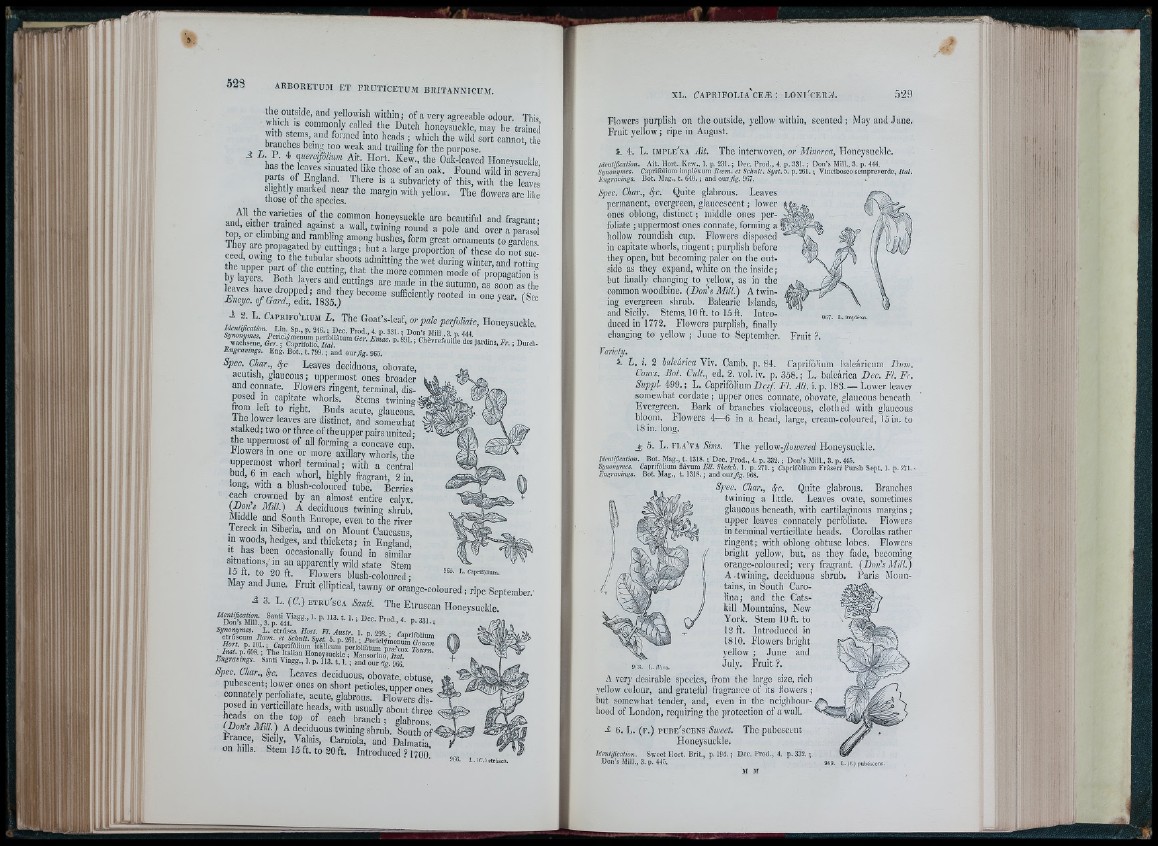
the outside, and yellowish within; of a very agreeable odour. This
which IS commonly called the Dutch honeysuckle, may be trained
with stems, and foimed into heads ; which the wild sort cannot the
branches being too weak and trailing for the purpose.
imVra Ait Hort. Kew., the Oak-leaved Honeysuckle
has the leaves sinuated like those of an oak. Found wild in several
parts of England. There is a subvariety of this, with the leaves
slightly marked near the margin with yellow. The flowers are like
those of the species.
a n r t 'i i r a ? '’?'!"® ? common honeysuckle are beautiful and fragrantand,
eithei trained against a wall, twining round a pole and over a narasol
top, or chmbing and rambling among bushes, form great ornaments to gLdens
ceed, owing to the tubular shoots admitting the wet during winter and rottiiw
to i r , f ‘’’® common m oL of pr’o p a g a Z I
i Z ? I £ r ''* “! cuttings are made in the autumn, as soon as the
™ ? fo® y “®®°'"® sufficiently rooted in one year. (See
A 2 L. Caprifo'lium L. The Goat’s-leaf, or pale perfoliate. Honeysuckle
; Dare-
Engravings. Eng. Bot., t. 799.; and ourfig. 965.
Spec. Char., 4c Leaves deciduous, obovate
acutish, glaucous; uppermost ones broader
and connate. Flowers ringent, terminal, dis-
posed m capitate whorls. Stems twining !
nom left to right. Buds acute, glaucous,
m e lower leaves are distinct, and somewhat
stalked; two or three ofthe upper pairs united;
uppermost of all forming a concave cup.
-blowers in one or more axillary wliorls, the
uppermost whorl terminal; with a central
bud, 6 in each whorl, highly fragrant, 2 in.
long, with a blush-coloured tube. Berries
e ^ h crowned by an almost entire calyx.
(.poa 5 MR.) A deciduous twining shrub.
Middle and South Europe, even to the river
lereck in Siberia, and on Mount Caucasus
m woods, hedges, and thickets; in England!
It has been occasionally found in similar
situations, in an apparently wild state Stem
Fl^^wers blush-coloured;
966. I,. Caprifblium.
May and June. Fruit elliptical, tawny or orange-coloured ; ripe September.’
A 3. L. (C.) ETRU'SCA Saati. The Etruscan H o n e y su c k le
" S M m . - , '■ P- =31.;
Synonymes. L. etrusca Hort. Fl. Austr 1 d . />o., «ixt-
etruscum Rcem. et Schult. Syst. 5. p. 261 •'p^ricl’e . k £ n ^ ^
Spee. Char., Sre. Leaves deciduous, obovate, obtuse
pubescent; lower ones on short petioles, upper onei!
connately perfoliate, acute, glabrous. Flowers dis
posed in verticillate heads, with usually about three
r? ? . ®"®“ kranch; glabrous
j j f r ¿ £ | ‘^ “f'd u o u s twining shrub. South of
France, Sicily, Valais, Carniola, and Dalmatia
on hills. Stem 15 ft. to 20 ft. Introduced ? 1700*
966. J-. fr.Wtrfisca.
i l L .
FlowervS purplish on th e outside, yellow within, scented ; May and June.
F ru it yellow ; ripe in August.
S. 4. L. i m p l e ' x a .Ait. The interwoven, or Minorca, TToneysuckle.
Identification. Ait. Hort. Kew., 1. p. 231. ; Dec. Prod., 4. p. 331. ; Don's Mil!., 3. p. 444.
Synonymes. CaprifòUum impléxum Riem, et Schult. Syst. 5. p. 261. ; Vincibosco sempreverde, Ital.
Éngravings. Bot. Mag., t. 640. ; and ourjig. 967.
üpec. Chnr., 4c. Quite glabrous. Leaves
permanent, evergreen, glaucescent ; lower
ones oblong, distinct ; middle ones perfoliate
; uppermost ones connate, forming a
hollow roundish ciq). Flowers clispo.sed
in capitate whorls, ringent ; pur|)lish before
they open, but becoming paler on the outside
as they expand, white on the inside;
but finally changing to yellow, as in the
common woodbine. {Don’s Mill.) A twining
evergreen shrub. Balearic Islands,
and Sicily. Stems. 10 ft. to 15 ft. Introduced
in 1772. Flowers purplish, finally
changing to yellow ; June to September. Fruit ?.
Variety.
1 L. i. 2 baleárica Viv. Camb. p. 84. rapi’ifoMum haleariciim Dum.
Cours. Bot. Cult., ed. 2. vol. iv. p. 358.; L. baleárica Dec. Fl. Fr.
Suppl. 499. ; L. Caprifolium Desf. Fl. Alt. i. p. 183- — Lower leave?
somewhat cordate ; upper ones connate, obovate, glaucous beneath.
Evergreen. Bark of branches violaceous, clothed with glaucous
bloom. Flowers 4—6 in a head, large, cream-coloured, 15 in. to
18 in. long,
J 5. L. f l a ' v a Sims. The yeWow-ßowcred Honeysuckle.
Ideniification. Bot. Mag., t. 1318. ; Dec. Prod., 4. p. 332. ; Don’s Mill., 3. p. 445.
Synonymes. Faprifòlium flàvum EU. Sketch. 1. p. 271. ; Caprifòlium Fràserì Pursh Sept. I. p. 271- ■
Engravings. BoL Mag., t. 1318.; and our A?- 968.
Spec. Char., 6/c. Quite glabrous. Branches
twining a little. Leaves ovate, sometimes
glaucous beneath, with caj'tilaginoiis margins ;
upper leaves connately perfoliate. Flowers
in terminal verticillate heads. Corollas rather
ringent; with oblong obtuse lobes. Flowers
bright yellow, but, as they fade, becoming
orange-coloured; very fragrant. {Doris MUl.)
A.twining, deciduous shrub. Paris Mountains,
in South Carolina;
and the Cats-
kill Mountains, New
York. Stem 10 ft. to
12 ft. Introduced ki
1810. Flowers bright
yellow ; June and
July. Fruit ?,
A very desirable species, from the large size, rich
yellow colour, and grateful fragrance of its flowers ;
but somewhat tender, and, even in the neigiibour-
liood of London, requiring the protection of a wall.
A (5. L. ( f . ) p u b e ' s c e n s Sweet. The pubescent
Honeysuckle.
Identification. Sweet Ilort. Brit., p. 194. ; Dec. Prod., 4, p. 332. ;
Don’s Mill., 3. p. 445.
ÄI nr
969. L. (f.) pubéfecci
I i; ¡J